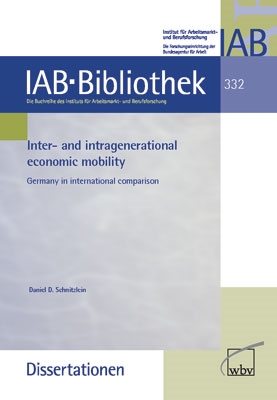Inter- and intragenerational economic mobility
Germany in international comparison
Die Ungleichheit der Lohneinkommen in Deutschland verschärft sich seit geraumer Zeit deutlich. Umso mehr muss zumindest die Gleichheit der Chancen in unserer Gesellschaft gewährleistet sein. Die Höhe des Einkommens sollte - aus gesellschaftlichen wie ökonomischen Gründen - von der individuellen Leistungsfähigkeit abhängen, nicht vom Status der Eltern. Doch wie ist es um die Gleichheit der Chancen in Deutschland tatsächlich bestellt? Ist das hiesige Einkommensgefüge so durchlässig, dass auch Menschen aus sozial schwachen Familien eine realistische Aufstiegschance haben? Wie hoch ist in Deutschland die ökonomische Mobilität zwischen sowie innerhalb von Generationen? Und wie schneidet Deutschland im Vergleich zu anderen Ländern ab? Daniel Schnitzlein untersucht diese Fragen mit neuen methodischen Ansätzen und analysiert die Ursachen für das unterschiedliche Ausmaß an ökonomischer Mobilität im internationalen Vergleich.
Publikationssprache: Englisch
Publikationssprache: Englisch
1 Introduction
1.1 Motivation
1.2 Organization of this dissertation
1.3 References
2 A new look at intergenerational mobility in Germany compared to the US
2.1 Introduction
2.2 Theoretical background
2.3 Empirical strategy
2.4 Data
2.5 Results
2.6 Conclusion
2.7 Figures and tables
2.8 References
3 How important is the family? Evidence from sibling correlations in permanent earnings in the US, Germany,and Denmark
3.1 Introduction
3.2 Literature review
3.3 Statistical model and empirical strategy
3.4 Data and sampling rules
3.5 Results
3.6 Robustness of the results
3.7 Conclusion
3.8 Tables
3.9 References
4 How important is cultural background for the levelof intergenerational mobility?
4.1 Introduction and background
4.2 Estimation strategy and data
4.3 Results
4.4 Conclusions
4.5 Tables
4.6 References
5 Wage mobility in East and West Germany
5.1 Introduction
5.2 Data and measurement issues
5.3 Inequality and mobility patterns in East and West Germany
5.4 Explaining the mobility decline: hypotheses and empirical approach
5.5 Results and discussion
5.6 Conclusions
5.7 Figures and tables
5.8 References
5.9 Appendix
5.10 Data appendix
5.11 Electronic appendix (not intended for publication)
6 Conclusive remarks
1.1 Motivation
1.2 Organization of this dissertation
1.3 References
2 A new look at intergenerational mobility in Germany compared to the US
2.1 Introduction
2.2 Theoretical background
2.3 Empirical strategy
2.4 Data
2.5 Results
2.6 Conclusion
2.7 Figures and tables
2.8 References
3 How important is the family? Evidence from sibling correlations in permanent earnings in the US, Germany,and Denmark
3.1 Introduction
3.2 Literature review
3.3 Statistical model and empirical strategy
3.4 Data and sampling rules
3.5 Results
3.6 Robustness of the results
3.7 Conclusion
3.8 Tables
3.9 References
4 How important is cultural background for the levelof intergenerational mobility?
4.1 Introduction and background
4.2 Estimation strategy and data
4.3 Results
4.4 Conclusions
4.5 Tables
4.6 References
5 Wage mobility in East and West Germany
5.1 Introduction
5.2 Data and measurement issues
5.3 Inequality and mobility patterns in East and West Germany
5.4 Explaining the mobility decline: hypotheses and empirical approach
5.5 Results and discussion
5.6 Conclusions
5.7 Figures and tables
5.8 References
5.9 Appendix
5.10 Data appendix
5.11 Electronic appendix (not intended for publication)
6 Conclusive remarks
weitere Infos
Schnitzlein, D.: Inter- and intragenerational economic mobility. Germany in international comparison. Bielefeld 2012. DOI: 10.3278/300770w
Schlagworte
- Bundesrepublik Deutschland
- Chancengerechtigkeit
- Chancengleichheit
- Dissertation
- Dänemark
- Einkommen
- Familie
- Geschwister
- Import
- Intergenerationsmobilität - Determinanten
- Intergenerationsmobilität - internationaler Vergleich
- Intragenerationsmobilität
- kulturelle Faktoren
- Leistungsfähigkeit
- Lohnhöhe
- Mobilität
- Open Access
- Organisation
- organizations
- soziale Herkunft
- USA
